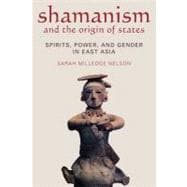
Note: Supplemental materials are not guaranteed with Rental or Used book purchases.
Purchase Benefits
What is included with this book?
| List of Figures | p. xi |
| Preface and Acknowledgments | p. xv |
| Orientation to Shamanism and the Origin of States: Spirit, Power, and Gender in East Asia | p. 1 |
| What Is Shamanism? | p. 3 |
| Who Were the Wu? | p. 5 |
| State Formation | p. 6 |
| Archaeology | p. 7 |
| Texts | p. 8 |
| Organization of the Book | p. 9 |
| Niuheliang, China | p. 14 |
| Landscapes, Legends, and Skyscapes | p. 19 |
| Landscapes | p. 19 |
| Myths and Legends | p. 31 |
| Skyscapes | p. 38 |
| Interaction between Earth and Heaven | p. 42 |
| Conclusion | p. 46 |
| The Puyang Burial, China | p. 47 |
| What is a Shaman? | p. 51 |
| The Archaeology of Religion, Magic, and Ritual | p. 54 |
| Shamans in Ethnology | p. 57 |
| Shamans in History | p. 61 |
| Other Beliefs and Rituals in East Asia | p. 63 |
| Practices of Shamans | p. 67 |
| Material Culture of Shamans | p. 68 |
| Current Shamanism in East Asia | p. 71 |
| Variability of Shamanisms in Ancient East Asia | p. 72 |
| Conclusion | p. 74 |
| Yoshinogari, Japan | p. 76 |
| Power, Leadership, and Gender | p. 81 |
| Shamanism and Power | p. 81 |
| Leadership Strategies | p. 84 |
| Theories of Leadership | p. 85 |
| Obtaining Power | p. 86 |
| Qualities of a Leader | p. 92 |
| Ideologies of Leadership | p. 93 |
| Women as Shamans and Leaders | p. 95 |
| Conclusion | p. 99 |
| Anyang, China, Tomb No. 5-Lady Hao | p. 100 |
| Shamans in the East Asian Neolithic | p. 105 |
| Neolithic Chronology | p. 109 |
| Possible Evidence of Neolithic Shamans | p. 112 |
| Conclusion | p. 138 |
| Kamegoaka, Japan | p. 140 |
| Shamanism in Early Chinese States | p. 143 |
| Evidence of Xia | p. 146 |
| Evidence of Shang | p. 151 |
| Means of Reaching the Spirits | p. 156 |
| Critiquing the Shaman Hypothesis | p. 162 |
| Warring States | p. 163 |
| Conclusion | p. 166 |
| Sanxingdui, China | p. 168 |
| Shamanism in Korea | p. 171 |
| Paleolithic and Neolithic | p. 172 |
| Bronze Age | p. 174 |
| The Han Commanderies | p. 179 |
| The Korean Three Kingdoms | p. 181 |
| Current Shamanism in Korea | p. 190 |
| Conclusion | p. 191 |
| Hwangnam Daecheong, Korea-Burial of a Ruling Queen? | p. 192 |
| Shamanism in the Japanese Islands | p. 199 |
| Kami | p. 200 |
| Japanese Archaeology | p. 200 |
| Early Japanese History | p. 207 |
| Shamanism in Present-Day Japan | p. 208 |
| Ryukyu Islands | p. 210 |
| Conclusion | p. 212 |
| Haniwa, Japan | p. 213 |
| Retying the Knots: Leadership, Ideology, Cultural Patterns, Gender, and Shamans in East Asia | p. 217 |
| Times, Trends, and Gender | p. 218 |
| Context and the Cultural Mosaic of East Asia | p. 224 |
| Other Gender Issues | p. 228 |
| Present-Day Shamanism in East Asia | p. 229 |
| Conclusion | p. 230 |
| References | p. 233 |
| Index | p. 265 |
| About the Author | p. 283 |
| Table of Contents provided by Ingram. All Rights Reserved. |
The New copy of this book will include any supplemental materials advertised. Please check the title of the book to determine if it should include any access cards, study guides, lab manuals, CDs, etc.
The Used, Rental and eBook copies of this book are not guaranteed to include any supplemental materials. Typically, only the book itself is included. This is true even if the title states it includes any access cards, study guides, lab manuals, CDs, etc.